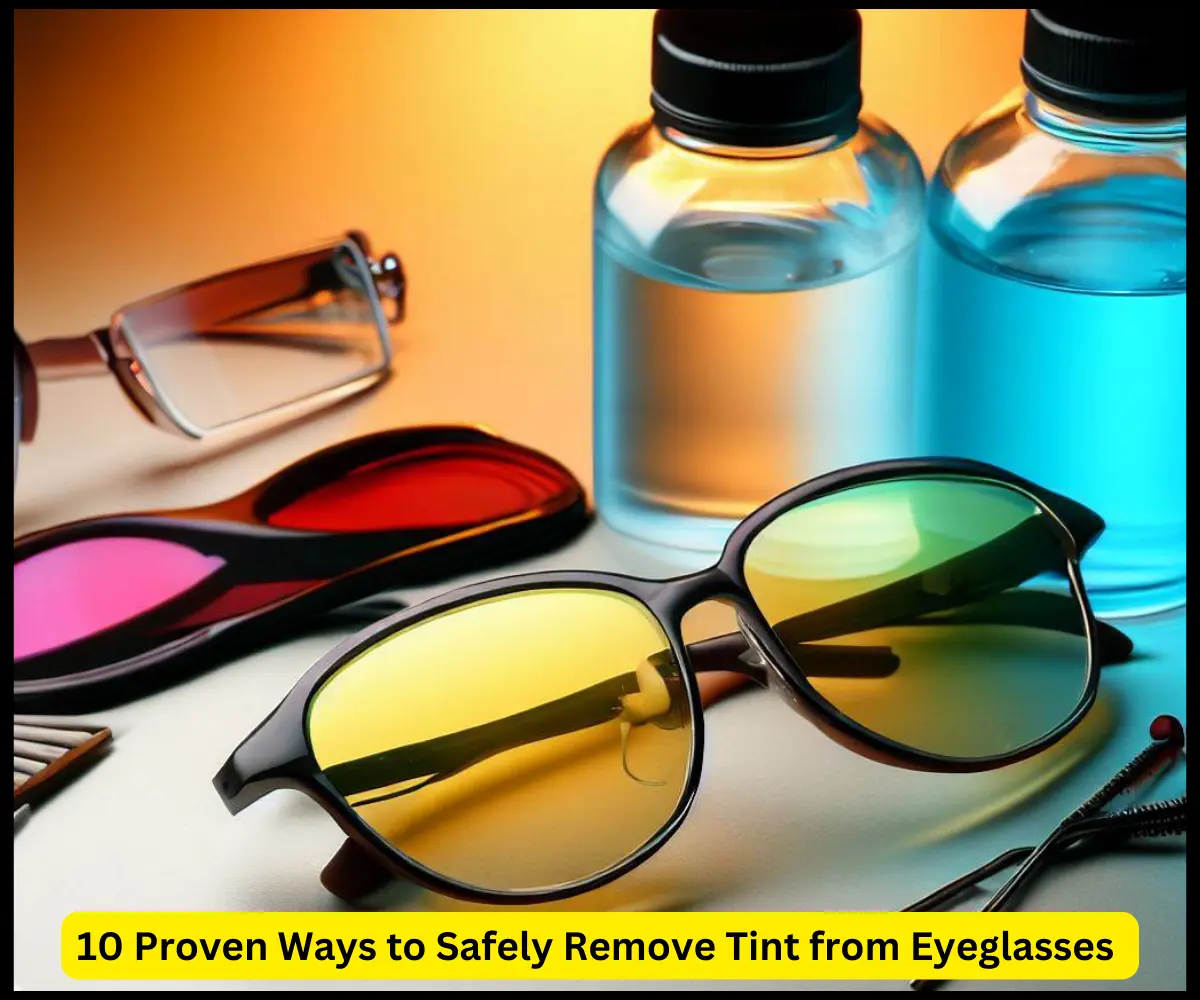Do your eyeglasses have an unnecessary tinted film or coating that makes indoor use difficult? Tints that once offered glare protection outdoors can become a headache when they overly darken your indoor vision or night driving sight.
Removing eyeglass tint provides benefits like clearer vision, relief from eyestrain headaches, and the ability to change your style. But take care – roughly scraping tint off lenses can ruin them through scratches or damage. You need to use the proper removal methods for your specific lens material and tint type.
In this comprehensive DIY guide, you’ll learn 10 proven ways to safely remove tint from eyeglasses at home. Detailed steps walk you through using products like rubbing alcohol, vinegar and acetone. You’ll also find tips for when professional removal by an optician is best to avoid lens damage.
With this guide’s help, you can restore clear vision, enjoy the flexibility of tint-free lenses, update your eyeglass style, and avoid the glare headaches caused by indoor tint.
Read on to finally remove annoying tint from your eyewear safely and effectively.
Why Should You Remove Tint from Eyeglasses?
Topics Covered In This Article
- 1 Why Should You Remove Tint from Eyeglasses?
- 2 10 Methods for Safely Removing Tint from Eyeglasses: A Complete Step-by-Step Guide
- 2.1 Method #1: Remove Light Tint with Window Cleaner
- 2.2 Method #2: Rubbing Alcohol for Darker Tints
- 2.3 Method #3: Apply Heat with a Hair Dryer
- 2.4 Method #4: Acetone as a Last Resort on Plastic Lenses
- 2.5 Method #5: Vinegar and Water Solution
- 2.6 Method #6: Lemon Juice as a Natural Tint Remover
- 2.7 Method #7: Soak in Hot Water then Gently Rub
- 2.8 Method #8: Optician Tint Removal Services
- 2.9 Method #9: Schedule Tint Removal at an Eye Doctor’s Office
- 2.10 Method #10: Use a Tint Removal Kit on Plastic Lenses
- 2.11 Tips for Safely Removing Tint from Eyeglasses
- 3 FAQs About Remove Tint from Eyeglasses
- 3.1 How can I remove really dark tinted eyeglass lenses?
- 3.2 What household products can remove tint without chemicals?
- 3.3 Will rubbing alcohol or nail polish remover ruin my lenses?
- 3.4 How do I get specialized tint off like photochromic or polarized lenses?
- 3.5 Can I just peel tint off my eyeglasses?
- 3.6 Will tint removal ruin any coatings on my lenses?
- 3.7 How do I avoid scratches when removing tint myself?
- 3.8 Can prescription eyeglass lenses have tint safely removed?
- 3.9 How do I remove old degraded tint from vintage eyeglasses?
- 3.10 Will my eye insurance cover tint removal costs?
- 3.11 How do you remove film from prescription glasses?
- 3.12 Why do my glasses have a dark tint?
- 3.13 How long does tint last on glasses?
- 3.14 Can blue light coating be removed from glasses?
- 3.15 Why are my prescription glasses tinted?
- 4 Bottom line on Remove Tint from Eyeglasses:
Here are some common reasons for removing tint from eyeglass lenses:
- The tint is too dark for indoor activities or nighttime vision
- You want to change to a lighter tint color or style
- The tint has faded, peeled, or otherwise degraded over time
- Your glasses look too casual due to dark tint and you need clear lenses
- Strain or fatigue from constantly looking through dark lenses indoors
First, inspect your eyeglasses to identify the lens material – often plastic, polycarbonate, or glass. Also note the frame material like metal, plastic, or titanium. Knowing the materials will determine the safest tint removal methods.
Common Tint Types Found on Eyeglass Lenses
Eyeglass tints come in many styles, including:
- Photochromic – Lenses darken when exposed to UV light
- Polarized – Reduces glare from specific angles
- Gradient – Darkens gradually from top to bottom
- Mirrored coating – Partially reflective colored tint
- Flash coating – Rainbow iridescent tint
Identifying your specific tint type will determine the best removal methods. Subtle anti-reflective and other coatings can also complicate tint removal in some cases.
10 Methods for Safely Removing Tint from Eyeglasses: A Complete Step-by-Step Guide
This comprehensive guide covers 10 ways to safely remove tint from eyeglasses, either yourself at home or by an eye care professional. Detailed steps are provided to remove even the most stubborn tint without damaging your lenses.
Method #1: Remove Light Tint with Window Cleaner

For lightly tinted plastic or polycarbonate lenses, standard household window cleaner containing ammonia can help lift and dissolve some tint films. Here is a step-by-step guide:
- Hold eyeglasses securely over a soft surface or towel in case you accidentally drop them during cleaning.
- Apply a small amount of window cleaner like Windex to the lenses.
- Gently wipe the window cleaner over the entire lens surface using a soft, lint-free microfiber cloth.
- Focus on wiping in a light circular motion to help dissolve the tint.
- Turn the glasses and wipe both sides of each lens to remove tint from all areas.
- Rinse the lenses thoroughly with cool clean water to remove any chemical residue.
- Dry the lenses completely using a fresh soft cloth or towel.
- Examine the lenses to see if more tint removal is needed. Repeat steps as necessary.
For light tints or tinted coatings, window cleaner may be enough to reveal clear transparent lenses again. Avoid using this method on glass lenses or lenses with anti-reflective coatings.
Method #2: Rubbing Alcohol for Darker Tints
For more stubborn darker tints, rubbing alcohol has strong solvent properties to dissolve and remove many tint films. Follow these steps:
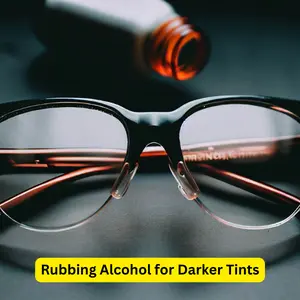
- Select a high concentration 90% or greater isopropyl alcohol for maximum effectiveness.
- Shake the alcohol bottle to mix contents before opening.
- Dampen a cotton ball or pad with a small amount of rubbing alcohol.
- Gently rub the cotton ball in circular motions across the surface of the tinted lens to dissolve the tint.
- Continue wiping with light pressure, re-dampening the cotton as needed, until the tint is removed.
- Flip the glasses and repeat the process on the other side of the lens.
- Once finished, rinse the lenses thoroughly under cool running water for 30 seconds to remove alcohol residue.
- Dry the lenses completely with a soft lint-free cloth.
The alcohol may temporarily give plastic lenses a cloudy appearance which will dissipate after rinsing. Spot test first on a small area of one lens to ensure the alcohol is compatible with the lens material and coatings.
Method #3: Apply Heat with a Hair Dryer
Heating eyeglass lenses can cause some tints to soften and partially lift off the surface. Follow these safe steps for using a hair dryer:
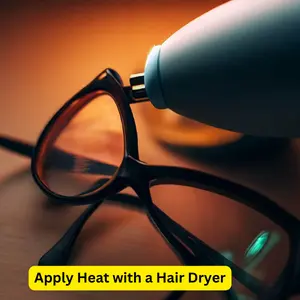
- Protect your eyes by putting on safety goggles before applying heat.
- Ensure glasses are held securely over a soft towel or surface.
- Set a hair dryer to the lowest heat and fan setting.
- Hold the hair dryer 6 to 8 inches away from the lenses to avoid overheating.
- Slowly move the dryer side to side over the front of the lenses for 30 seconds until warmed.
- Carefully wipe the lenses with a clean microfiber cloth to remove softened tint.
- Repeat heating and wiping on the back side of the lenses as needed.
- Avoid applying concentrated heat in one spot which can crack the lens.
The heat method works best on plastic and polycarbonate lenses.
Avoid using on glass, gas permeable, or vintage plastic lenses which can warp under heat. Test a small area first.
Method #4: Acetone as a Last Resort on Plastic Lenses
For the most difficult tints that won’t budge, acetone-based nail polish remover is a strong solvent option. But use with extreme care due to risks of damage:
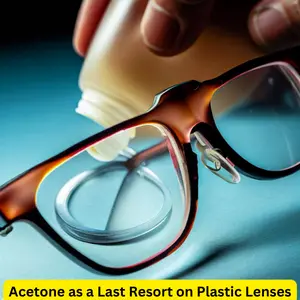
- Never use acetone on plastic lenses as it can fuse tint permanently or melt surfaces.
- Only apply to polycarbonate or glass lenses after testing a hidden spot first.
- Work in a well-ventilated area and use minimal acetone due to harsh fumes.
- Use a cotton pad or ball to gently wipe a small amount of acetone on the tinted lens surface.
- Allow 30 seconds of contact before wiping off dissolved tint and rinsing thoroughly with water.
- Repeat as needed but limit acetone contact time to avoid lens damage.
- Inspect closely for any signs of haze or damage before applying more acetone.
Save acetone only for the most desperate tint situations. It can permanently damage lenses and coatings if misused.
Proper ventilation is critical due to toxic fumes.
Method #5: Vinegar and Water Solution
For those wanting to avoid chemicals, vinegar can dissolve some types of tint. Create a solution by following these steps:
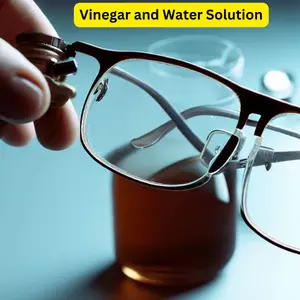
- Mix equal parts white household vinegar and warm clean water together in a small bowl or glass.
- Dip a soft, lint-free cloth into the vinegar solution until damp but not overly wet.
- Gently wipe the damp cloth over the tinted eyeglass lens surface.
- Focus on rubbing in light circles to help break down the tint.
- Re-dampen cloth as needed until tint begins dissolving.
- Rinse lenses thoroughly under cool running water when finished.
- Dry lenses completely with a fresh soft cloth.
The acetic acid in vinegar dissolves many tints without chemicals.
Avoid using vinegar solution on lenses with special coatings which can be damaged.
Method #6: Lemon Juice as a Natural Tint Remover
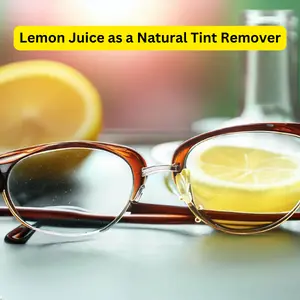
Similar to vinegar, the citric acid in lemon juice can also break down tinted coatings on lenses.
Follow these natural steps to remove tint:
- Squeeze fresh lemon juice from 1-2 lemons into a small bowl or glass.
- Dip a cotton ball or soft cloth into the lemon juice until fully dampened.
- Gently wipe the damp cotton over the tinted lens, focusing on stained areas.
- Allow lemon juice to sit for 30 seconds before wiping off.
- Re-apply lemon juice as needed to lift stubborn tint.
- Rinse lenses thoroughly when finished and dry with a soft cloth.
Lemon juice removes many tints without harming lenses. The natural acid works similarly to vinegar. Rinse promptly if you notice any damage beginning.
Method #7: Soak in Hot Water then Gently Rub
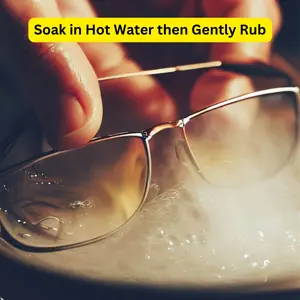
For plastic eyeglasses, soaking in hot water can help loosen some tinted coatings so they can be wiped away.
Use this safe process:
- Fill a bowl with very hot, but not boiling, tap water.
- Completely submerge eyeglass lenses in the hot water.
- Let lenses soak for 5-10 minutes until tint appears loosened.
- Remove glasses from water and gently wipe lenses with fingertips in a circular motion.
- The tint should begin wiping away. Repeat soaking and rubbing if needed.
- Avoid very high temperatures that could warp plastic frames.
The combination of heat and friction from rubbing can help dissolve and lift tints without chemicals. Only use this method on plastic lenses to avoid cracking glass.
Method #8: Optician Tint Removal Services
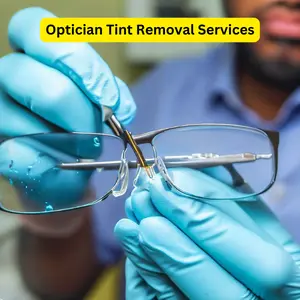
For the most reliable results with minimal risk of damage, visit an eyeglass store or optician to have tint professionally removed.
Services typically include:
- Assessing lens material and tint type
- Using specialized tools to remove tint
- Applying commercial-grade tint strippers
- Avoiding damage to underlying lens
- Polishing lenses after tint removal
Major national chains like LensCrafters offer tint removal for around $25-$50. Independent opticians may charge slightly more. This option costs more than DIY but provides expert service to protect your lenses.
Method #9: Schedule Tint Removal at an Eye Doctor’s Office
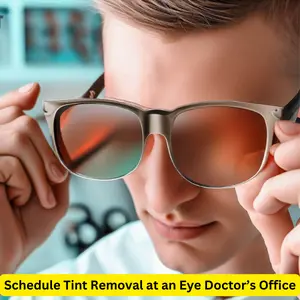
Your ophthalmologist or optometrist office may also provide professional tint removal. Benefits of removal during an eye exam include:
- Your doctor can examine lenses after tint removal
- Prescription can be checked and updated if needed
- Damaged lenses may be replaced with your updated prescription
- Convenient to have done during prescription eyeglass exam
Costs are similar to optician services, ranging from $30 to $60 in most cases depending on local rates. Check with your eye doctor to see if they offer tint removal services.
Method #10: Use a Tint Removal Kit on Plastic Lenses
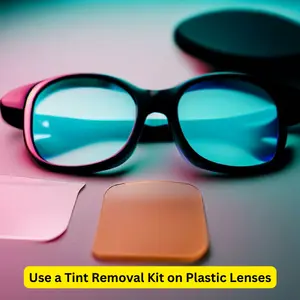
Some products are designed specifically for removing tint at home without damage.
Look for a kit that contains:
- Suction cups to secure glasses
- Razor blade or scraping tool
- Polishing compound
- Detailed instructions
These kits allow safe scraping followed by polishing for clear lenses again. Only use kits made for plastic lenses.
Follow instructions closely to avoid scratches.
Tips for Safely Removing Tint from Eyeglasses
Here are some important tips when removing tint at home:
- Use the gentlest method that is effective
- Never scrape lenses with unprotected tools
- Fully rinse chemicals after use
- Spot test removers on a small hidden area first
- Avoid heat on glass, vintage, or gas permeable lenses
- Work slowly and cautiously to avoid lens scratches
With patience and care, most modern eyeglass tint can be removed safely at home. For vintage, prescription, or expensive sunglass lenses, consider professional help to prevent damage.
Now I conclude the best and safe way to remove tint from eyeglasses.
What is the safest way to remove tint from eyeglasses?
The safest method to remove eyeglass tint without risk of damage is having it professionally done by an experienced optician. Opticians have specialized tools, solutions, and expertise to remove tints from plastic, polycarbonate, or glass lenses without causing scratches or other harm. They can assess your specific tint type and lens material to determine the ideal approach. While professional tint removal is more expensive than DIY options, it provides great results while protecting your prescription or coated eyeglass lenses from accidental damage.
What is the best way to remove tint from eyeglasses?
For most modern plastic and polycarbonate eyeglass lenses, the best tint removal option is rubbing alcohol. By dampening a cotton pad with 90% isopropyl alcohol and gently wiping the lenses in circles, you can dissolve even very stubborn tinted coatings. The alcohol has strong solvent properties to break down tint without high risk of lens damage. Just be sure to rinse thoroughly after using and spot test on a small area first. Compared to other household products, rubbing alcohol works quickly and effectively for DIY tint removal. It’s inexpensive and accessible, making it the best first method to try at home.
FAQs About Remove Tint from Eyeglasses
How can I remove really dark tinted eyeglass lenses?
For very dark tints, try rubbing alcohol applied with cotton balls and wiped gently in circles. Acetone is also effective on heavy tint, but test on a small area first to ensure it won’t damage the lenses. As a last resort, see an optician for professional tint removal.
What household products can remove tint without chemicals?
Some household products make effective natural tint removers. A 50/50 white vinegar and warm water solution can break down tint when wiped on lenses. Lemon juice also naturally lifts many tint films. For plastic lenses, hot water and gentle rubbing works.
Will rubbing alcohol or nail polish remover ruin my lenses?
Rubbing alcohol and acetone polish remover can damage some eyeglass lens materials and coatings if left on too long. Avoid acetone on plastic lenses. Rubbing alcohol is safer, but rinse immediately after tint removal. Test products first on an inconspicuous lens area.
How do I get specialized tint off like photochromic or polarized lenses?
Photochromic and polarized tints require professional removal in most cases. The polarization and treatments make them too risky for DIY methods. Consult an experienced optician for safe removal without damaging the underlying lens or your vision.
Can I just peel tint off my eyeglasses?
Never peel tint off lenses as it can remove coatings or damage the lens surface. Exceptions are tints designed to peel off like stick-on color filters. Any painted, sprayed or embedded lens tint must be dissolved with chemical removers rather than peeled.
Will tint removal ruin any coatings on my lenses?
Tint removal can potentially damage anti-reflective, UV protection, scratch resistant and other lens coatings. Use the gentlest method possible and spot test removers first. Avoid abrasive rubbing. For expensive coated lenses, professional removal is best.
How do I avoid scratches when removing tint myself?
Work over a soft towel to cushion if dropped. Wipe tint with gentle circular motions using soft cloths. Rinse chemicals off quickly. Start with the least risky remover like window cleaner and stop if lenses show signs of scratching. Tint removal kits include polish to restore lens clarity.
Can prescription eyeglass lenses have tint safely removed?
It’s possible but risky to DIY tint removal on prescription lenses. The coatings and precise prescriptions make them susceptible to damage. Have an optician or eye doctor perform tint removal on prescription glasses to avoid ruining the lenses.
How do I remove old degraded tint from vintage eyeglasses?
Vintage eyeglass tint is often fused on and risky to remove yourself. The aged plastic, coatings and adhesives require expert handling. Consult a vintage eyewear specialist for safe removal without harming the value of collectible vintage glasses.
Will my eye insurance cover tint removal costs?
Vision insurance may cover tint removal from prescription eyeglasses depending on your plan, deductible and reason for removal. For example, if the tint is medically necessary to change due to vision issues. Call your insurance provider to determine if any portion is covered before having tint professionally removed.
How do you remove film from prescription glasses?
It’s best to have tint or coating professionally removed from prescription lenses to avoid damage. Opticians use safe techniques and solutions to remove films without harming the precise prescription lens surface. DIY chemical removers risk ruining prescription glasses.
Why do my glasses have a dark tint?
Glasses may come with a factory tint to block glare or UV rays. Or you may have selected tinted lenses for visual comfort in bright light. Over time, cleaners, oils and wear can also darken lenses. If bothersome, try having the tint professionally removed by an optician.
How long does tint last on glasses?
Tint durability depends on lens material and tint type. Factory tints on plastic lenses last 1-2 years typically before fading. Higher quality tints applied by an optician may last 3-5 years or longer before needing replacement. Photochromic and polarized tints have the shortest lifespan of 1-2 years.
Can blue light coating be removed from glasses?
Yes, anti-blue light lens coatings can be removed by an experienced optician using a chemical bath process. But take care to prevent damage to the underlying lens since blue light coatings bond tightly. DIY removal risks ruining prescription lenses.
Why are my prescription glasses tinted?
Prescription eyeglasses often come with a mild tint from the factory to provide subtle glare reduction and UV protection. Stronger tints are sometime added if you experience light sensitivity disorders. Ask your optician to remove unnecessary bothersome tint.
Bottom line on Remove Tint from Eyeglasses:
As you learned, tinted eyeglass lenses can be effectively removed using the proper techniques for your specific lenses. With some trial and error, rubbing alcohol, vinegar, acetone and other removers lift away tint gently when done carefully.
The key is identifying your lens material first, then using the mildest removal method that gets the job done. Taking your time helps avoid scratches or other permanent damage. If in doubt, seek professional help from an experienced optician.
With clearer vision and no more headaches from indoor tint, you can enjoy your glasses much more. Change up your style by removing old faded tints and replacing them with new ones as desired. Follow this guide to safely remove annoying tint from eyeglasses and see your world more clearly.
If you are not comfortable using either of these methods for Remove Tint from Eyeglasses, there are several products on the market that are designed specifically for removing tints from eyeglasses. These products usually come in a kit that includes a pair of pliers, a razor blade, and a set of instructions.


Follow the instructions included with the kit to remove the tint from your eyeglasses. If you are not able to remove the tint using one of these methods, you may need to consult an optometrist or ophthalmologist for assistance.

Robert Perry is a leading expert in the world of eyewear. His wealth of experience and unique insight in the realm of gaming glasses, swimming goggles, sunglasses, eyeglasses, and computer glasses has set him apart in the industry.
A keen observer of daily fashion styles and the utility of glasses in various lifestyles, Perry is passionate about empowering individuals with knowledge on eyewear selection. He is known for his thorough, clear, and relatable analysis, making it easier for readers to find the perfect glasses for their specific needs.
Perry’s writings consistently reflect his understanding of both function and fashion, affirming his position as an influential figure in the eyewear community.

